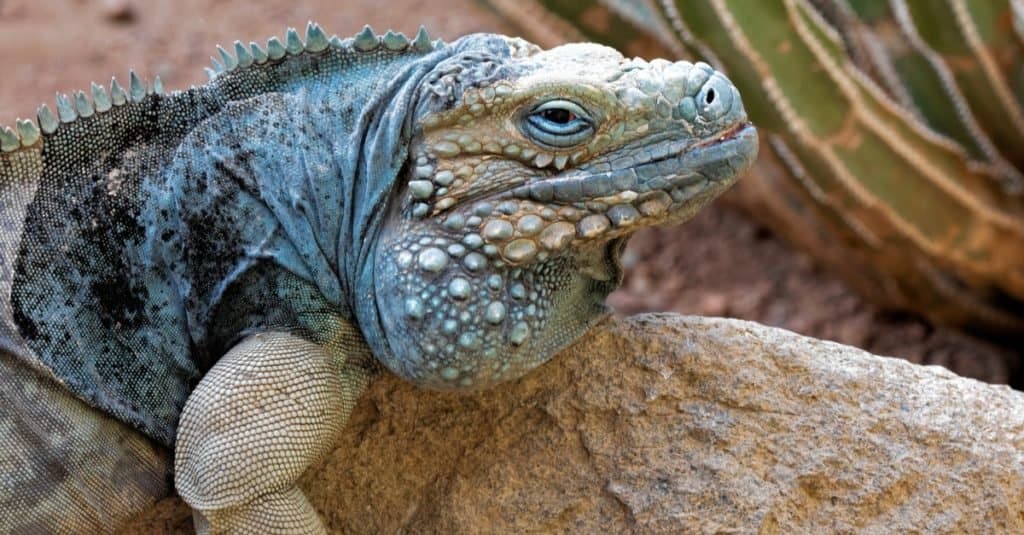
The post How the Blue Iguana Was Saved from the Brink of Extinction appeared first on A-Z Animals.
In 2002, there were fewer than 25 individual blue dragons, or blue iguanas, left in the wild. Thanks to conservation efforts where this unique reptile is safely hatched and raised in captivity for its first few years, the blue iguana has made a comeback. Because blue iguanas are only found on Grand Cayman Island, they are particularly vulnerable to threats to their survival.

The Grand Cayman blue iguana is an endangered species endemic to Grand Cayman Island.
©DnDavis/Shutterstock.com
What Is a Blue Dragon?
Not to be confused with the blue dragon sea slug, this dragon-like reptile is an iguana. The Grand Cayman Blue Iguana (Cyclura lewisi) is the largest native land animal in Grand Cayman. They can grow over five feet long and weigh more than 25 pounds. Blue iguanas range in color from gray to dusky blue, but they turn bright blue during mating season. The females are more of a greenish hue, while the males can be a vibrant turquoise.
Blue iguanas have long lifespans. In captivity, they can live over 60 years, while in the wild, they can live from 25 to 40 years. They are active during the day and bask in the sun in the morning to warm up. Their diet consists mostly of plants, including papaya, mango, hibiscus, and many other native plant species. They do, however, eat the occasional insect or crustacean.
Threats to the Blue Iguana
The Cayman Islands were uninhabited until the 1660s and not permanently settled until the 1730s. Because the islands are not connected to the mainland, species and subspecies evolved here that aren’t found anywhere else on earth. The islands were home to many reptiles and birds, with bats being the only mammals native to the Cayman Islands.
Blue iguanas once thrived on Grand Cayman Island with very few predators. That is, until humans arrived. Early settlers hunted the blue iguanas in coastal areas, reducing their population. Humans also brought invasive predators with them. Today, blue iguanas are preyed upon by a large stray cat and dog population. Rats that had hitched a ride with settlers inhabit the island today, eating hatchlings and juvenile iguanas. Habitat loss is yet another threat facing the blue iguanas.
How a Captive Breeding Program Helps the Blue Iguana
With efforts from conservationists, blue iguanas have been reclassified from “critically endangered” by the IUCN Red List of Threatened Species to “endangered.” The National Trust for the Cayman Islands has released over 1,200 blue iguanas into the wild through their captive breeding program.

Queen Elizabeth II Botanic Park is home to the Blue Iguana Conservation Facility.
©Chiyacat/Shutterstock.com
Blue iguana eggs and hatchlings are highly vulnerable to predation. A female blue iguana lays 3 to 18 eggs per season. Iguanas are solitary animals except during the mating season. The females typically stay in one area, while the males may wander long distances in search of a mate. Females only tolerate males during mating. Afterwards, they become territorial and aggressive, chasing the males away. Females lay their eggs in their burrows, but the hatchlings do not stay in their mother’s burrow for long. As soon as the babies hatch, the little lizards disperse, heading for the shelter of the trees. In addition to invasive predators, hatchlings must also avoid native snakes.

Blue iguana populations are in danger of habitat loss and invasive predators.
©chaikotskiy/Shutterstock.com
To help boost the blue iguana population and give them a head start, the National Trust for the Cayman Islands began a captive breeding program. Conservationists scour the island searching for blue iguana eggs. They collect the eggs from the wild nests and bring them back to a safe environment. The eggs are incubated, and the young are safely raised until they are released back into the wild at around two to three years of age. At this age, the blue iguanas are sexually mature and not nearly as vulnerable to predators as when they were younger.
Other Conservation Efforts
Blue iguanas continue to need protection after they are released back into the wild. In addition to the captive breeding program, conservationists are helping the iguanas by expanding protected areas, controlling invasive species, and conducting field research through GPS monitoring and wildlife cameras. Frederic Burton, director of the Blue Iguana Recovery Program, told CNN Science that feral cats remain an ongoing problem for the survival of the blue iguana.

Blue iguanas wander freely throughout the protected Queen Elizabeth II Botanic Park.
©Blue Sky imagery/Shutterstock.com
The designated protected areas for blue iguanas include Colliers Wilderness Reserve, the Salina Reserve, and Queen Elizabeth II Botanic Park. The Botanic Park is also the location of the Blue Iguana Conservation Breeding Facility. Visitors can explore the park and see many blue iguanas, raised by conservationists, roaming the area.
The post How the Blue Iguana Was Saved from the Brink of Extinction appeared first on A-Z Animals.
August 14, 2025 at 06:32PMJennifer Geer
.jpeg)
.jpeg)

0 Comments